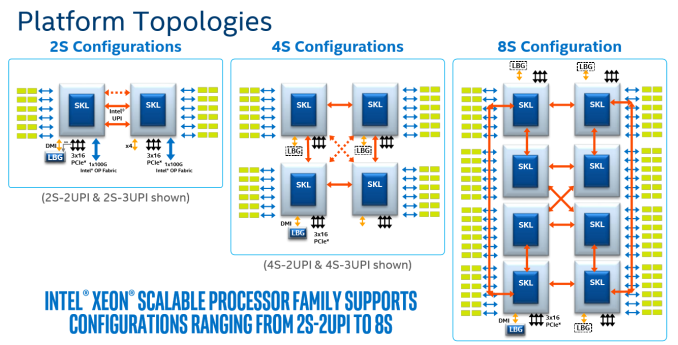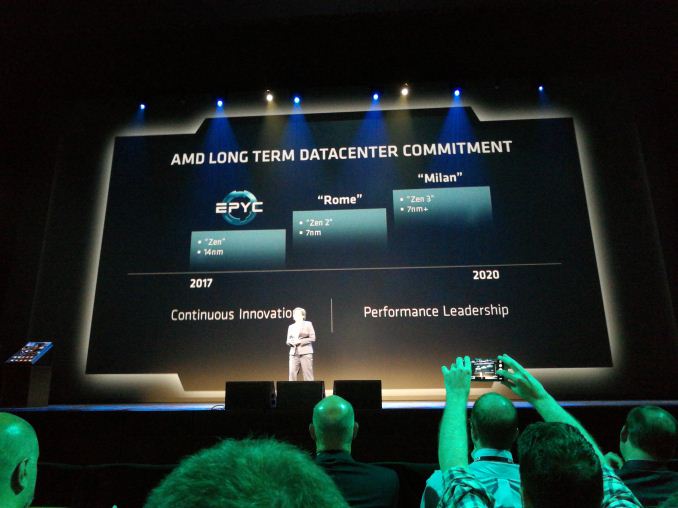Sizing Up Servers: Intel's Skylake-SP Xeon versus AMD's EPYC 7000 - The Server CPU Battle of the Decade?
by Johan De Gelas & Ian Cutress on July 11, 2017 12:15 PM EST- Posted in
- CPUs
- AMD
- Intel
- Xeon
- Enterprise
- Skylake
- Zen
- Naples
- Skylake-SP
- EPYC
Closing Thoughts
First of all, we have to emphasize that we were only able to spend about a week on the AMD server, and about two weeks on the Intel system. With the complexity of both server hardware and especially server software, that is very little time. There is still a lot to test and tune, but the general picture is clear.
We can continue to talk about Intel's excellent mesh topology and AMD strong new Zen architecture, but at the end of the day, the "how" will not matter to infrastructure professionals. Depending on your situation, performance, performance-per-watt, and/or performance-per-dollar are what matters.
The current Intel pricing draws the first line. If performance-per-dollar matters to you, AMD's EPYC pricing is very competitive for a wide range of software applications. With the exception of database software and vectorizable HPC code, AMD's EPYC 7601 ($4200) offers slightly less or slightly better performance than Intel's Xeon 8176 ($8000+). However the real competitor is probably the Xeon 8160, which has 4 (-14%) fewer cores and slightly lower turbo clocks (-100 or -200 MHz). We expect that this CPU will likely offer 15% lower performance, and yet it still costs about $500 more ($4700) than the best EPYC. Of course, everything will depend on the final server system price, but it looks like AMD's new EPYC will put some serious performance-per-dollar pressure on the Intel line.
The Intel chip is indeed able to scale up in 8 sockets systems, but frankly that market is shrinking fast, and dual socket buyers could not care less.
Meanwhile, although we have yet to test it, AMD's single socket offering looks even more attractive. We estimate that a single EPYC 7551P would indeed outperform many of the dual Silver Xeon solutions. Overall the single-socket EPYC gives you about 8 cores more at similar clockspeeds than the 2P Intel, and AMD doesn't require explicit cross socket communication - the server board gets simpler and thus cheaper. For price conscious server buyers, this is an excellent option.
However, if your software is expensive, everything changes. In that case, you care less about the heavy price tags of the Platinum Xeons. For those scenarios, Intel's Skylake-EP Xeons deliver the highest single threaded performance (courtesy of the 3.8 GHz turbo clock), high throughput without much (hardware) tuning, and server managers get the reassurance of Intel's reliable track record. And if you use expensive HPC software, you will probably get the benefits of Intel's beefy AVX 2.0 and/or AVX-512 implementations.
The second consideration is the type of buyer. It is clear that you have to tune more and work harder to get the best performance out of AMD EPYC CPUs. In many ways it is basically a "virtual octal socket" solution. For enterprises with a small infrastructure crew and server hardware on premise, spending time on hardware tuning is not an option most of the time. For the cloud vendors, the knowledge will be available and tuning for EPYC will be a one-time investment. Microsoft is already deploying AMD's EPYC in their Azure Cloud Datacenters.
Looking Towards the Future
Looking towards the future, Intel has the better topology to add more cores in future CPU generations. However AMD's newest core is a formidable opponent. Scalar floating point operations are clearly faster on the AMD core, and integer performance is – at the same clock – on par with Intel's best. The dual CCX layout and quad die setup leave quite a bit of performance on the table, so it will be interesting how much AMD has learned from this when they launch the 7 nm "Rome" successor. Their SKU line-up is still very limited.
All in all, it must be said that AMD executed very well and delivered a new server CPU that can offer competitive performance for a lower price point in some key markets. Server customers with non-scalar sparse matrix HPC and Big Data applications should especially take notice.
As for Intel, the company has delivered a very attractive and well scaling product. But some of the technological advances in Skylake-SP are overshadowed by the heavy price tags and somewhat "over the top" market segmentation.












219 Comments
View All Comments
Panxa - Sunday, July 16, 2017 - link
"Competition has spoiled the naming convention Intels 14 === competetions 7 or 10"The node naming convention used to be the gate length, however that has become irrelevant. Intel 14 nm gate lenghth is about 1.5x and 10 nm about 1.8x. Companies and organizations have developed quite accurate models to asses process density with equations based on process poarameters like CPP and MPP to what they call a "standard node"
"Intel used to maintain 2 year lead now grew that to 3-4year lead"
Don't belive intel propaganda. Intel takes the lead in 2014 with their 14nm process with a standard node value of 12.1. Samsung and then TSMC take the lead in 2017 with their 10nm processes having standard node values of 11.2 and 10.3 respectively. Intel will retake the the lead back when they deliver their 10nm process with a standard node value of 8.3. However it will be a short lived lead, TSMC will retake the lead back with their 7nm with a standard node of 7.9 before GLOBALFOUNDRIES takes the lead in 2018 with their 7nm process with a standard node value of 7.8. The gap is gone !!!
"yet their revenue profits grow year over year"
Wrong. Intel revenue for the last years remained fairly constant
2011 grow
2012 decline
2013 decline
2014 grow
2015 decline
2016 grow
All in all from 2011 to 2016 revenue went from 54 billion to 59 billion. If we take into account inflation $54 billion in the year 2011 is worth $58.70 billion today.
Not to mention that Samsung has overtaken Intel to become the world No.1 semiconductor company, and that a "pure play" foundry like TSMC has surpassed intel in market CAP
johnp_ - Wednesday, July 12, 2017 - link
The Xeon Bronze Table on Page 7 seems to have an error. It lists the 4112 as having 5.50MB L3, but ark says it has 8.25MB, just like the 3104, so it looks like it has an above-average L3/Core:https://ark.intel.com/products/123551
Ian Cutress - Friday, July 14, 2017 - link
I've got Intel documents from our briefings that say it has the regular 1.375MB/core allocation, and others saying it has 8.25MB. I'm double checking.johnp_ - Friday, July 21, 2017 - link
All commercial listings and most reviews I've seen online show the processor with 8.25MB as well.Do you have any further information from Intel?
pepoluan - Wednesday, July 12, 2017 - link
What I'm dying to know: Performance when running as virtualization host. Using Xen, VMware, and Hyper-V.Threska - Saturday, July 22, 2017 - link
Virtualization itself, and more importantly virtualization security.Sparkyman215 - Wednesday, July 12, 2017 - link
Typo here: Intel will seven different versions of the chipset, varying in 10G and QAT support, but also varying in TDP:tmbm50 - Wednesday, July 12, 2017 - link
One thing to consider when considering value is the Microsoft Server 2016 core tax.....assuming your mission critical apps are still tied to MS ;-)Server 2016 now chargers per core with an 8 core socket as the base. The Window license for a 32 core server is NUTS.
I'm surprised AMD and Intel are not pushing Microsoft on this. For datacenters like ourselves its pushing us to 8 core sku's with more 2U nodes.
msroadkill612 - Wednesday, July 12, 2017 - link
Aye, its a fuuny world lad.The way the automobile panned out differently in different countries, was laargely die to fuel tax regimes, rather than technology.
i.e. what is the best way to cheat a bit on the incumbent tax rules of germany/france/uk vs a more laissez faire USA. In UK, u were taxed on horsepower, but u could cheat a bit w/ hi revs & more gears - that sort of thing.
rahvin - Wednesday, July 12, 2017 - link
Who runs any Windows service on bare metal these days? If you haven't virtulalized your windows servers running on KVM you should.